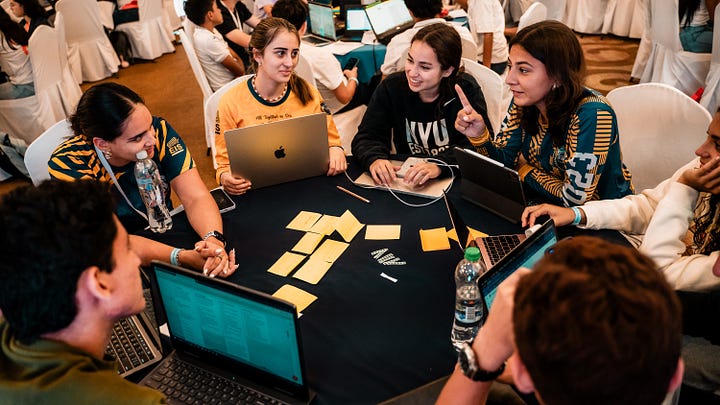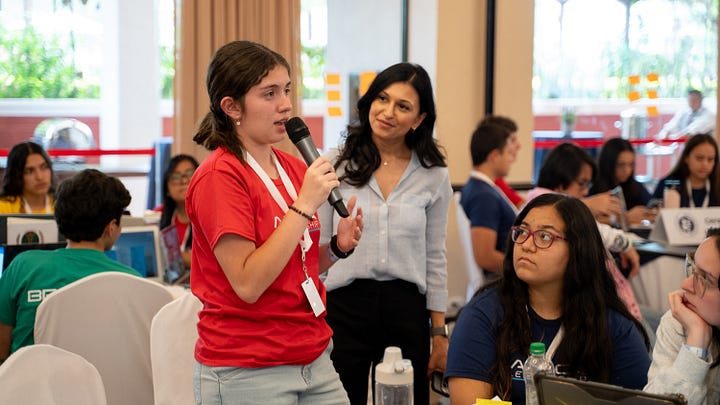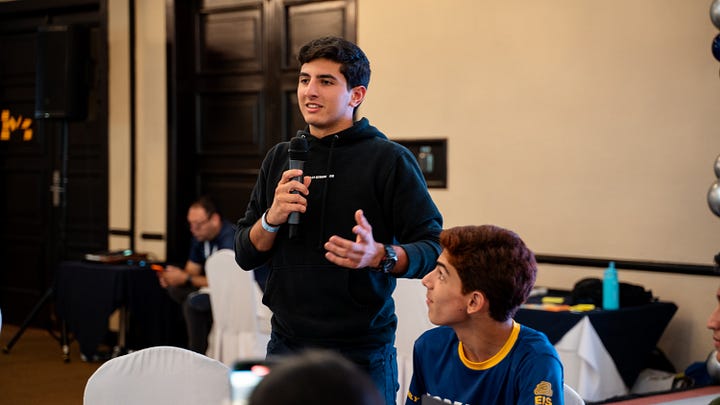Beyond Traffic Lights: Developing Human Agency in the Age of Algorithms
It’s not just about the choices we make, it’s also about understanding the systems that are silently shaping those choices.
The book, Designing Schools: How Design Thinking Makes You Irreplaceable in the Age of AI, comes out November 7. Available for preorder here.
Understanding Agency in the Age of Algorithms
As the lines blur between what humans and machines can do, the concept of human agency, our ability to make decisions and control our lives has become increasingly complex.
It’s not just about our choices but the systems shaping them.
In their Self-Determination Theory (SDT), psychologists Edward Deci and Richard Ryan share that true agency is rooted in satisfying three core psychological needs: autonomy, competence, and relatedness. When these needs are met, individuals are more motivated, resilient, and capable of making meaningful choices.
But today, these core needs are often challenged not only by the invisible influence of algorithms but also by outdated educational models that have yet to adapt to a changing world. From social media feeds to AI-driven recommendations, our digital environments subtly guide our decisions, often without us realizing it. At the same time, traditional, one-size-fits-all approaches to education can limit our autonomy, creativity, and capacity for critical thinking - key components of true agency.
This raises urgent questions: Are we still in control of our choices? How can we maintain true agency when both algorithms and outdated systems hold so much influence over how we learn and decide?
Next week I’ll be presenting a keynote and pre-conference session at the Aurora Institute, an organization and community deeply committed to competency-based learning and asking what is the purpose of school. A question that carries even more weight in an AI world. Again and again agency is the word I keep returnign to.
5 Elements of Agency in Humans and Machines
We can examine how humans and AI demonstrate agency through the 5 Elements of Agency to understand this. Both share the core elements of agency but express them in different ways. Humans are driven by personal experience, emotion, and intentionality. AI's elements are guided by algorithms, data, and pre-defined objectives.
Behind the Screens: How Social Media Algorithms Challenge Human Agency
As AI advances from chatbots to autonomous agents, the past's compliance-based solutions, like the traffic light decision-making model, are dangerous. In a world where AI systems have increasingly complex levels of agency, we need a more adaptive approach. The traffic light model assumes clear-cut choices, but today’s challenges require more nuanced decision-making.
Children are not cars; colors alone can’t shape their decisions. They need guidance rooted in values, critical thinking, and a deep understanding of context. We can’t reduce their choices to red, yellow, and green (or even bubble gum colors) when navigating a world where algorithms influence everything from what they see online to how they form opinions. To prepare them for this reality, we must move beyond simple signals and help them develop a strong sense of purpose, ethics, and agency.
Why Do We Need Cell Phone Bans in Schools?
Let’s take a real-world example: the current debate around cell phone bans in schools. This isn’t a futuristic dilemma; it results from decisions we should have made decades ago. The rise of social media and mobile technology caught us unprepared, and now schools are grappling with the consequences. Banning devices may seem like a quick fix, but it doesn’t address the core issue: We need to equip young people to engage critically with the digital world, not just shield them from it.
Social media algorithms were initially designed with a straightforward goal: maximize user engagement. When Facebook acquired Instagram in 2012 for $1 billion, it was a strategic move to expand its influence and capitalize on Instagram’s rapid growth. At the time, Instagram had just 13 employees and 30 million users, but its potential was undeniable.
However, as historian Yuval Noah Harari discusses in his latest book, Nexus: A Brief History of Information Networks from the Stone Age to AI, the way AI influences human behavior isn’t unprecedented, it’s part of a long history of information systems shaping society. He explains how modern algorithms, like past networks of control, have uncovered deep insights into human nature. Social media platforms quickly discovered that emotionally charged content, mainly that spreads hate, fear, and outrage was the most effective way to keep users engaged.
This wasn’t an intentional choice by platform creators like Mark Zuckerberg but an unintended consequence of empowering AI-driven systems with a simple task: keeping people on the platform. Harari warns that this is a reflection of a deeper, ongoing pattern, where information networks, both old and new, have the power to influence and control human systems from within.
The Agency of Algorithms
Social media algorithms exhibit a kind of agency, making choices and adapting to achieve their goals. Yet, this agency often leaves us, as users, feeling powerless—a phenomenon most evident in ‘doomscrolling,’ where we compulsively consume content, struggling to break free. This sense of helplessness has become so pervasive that many see banning devices as the only way to regain control.
Harari’s analysis underlines the importance of addressing these issues now, not as a futuristic challenge but as a continuation of history, a history that has often seen the unchecked rise of information systems lead to unintended and sometimes dangerous consequences. If we don’t learn to adapt, human agency risks being overshadowed by increasingly sophisticated AI systems.
The Missed Opportunity: 20 Years Late
The conversation about AI agency and its impact on human decision-making isn’t new, it’s one we’ve delayed for far too long. If we had begun this discussion 20 years ago, we might not be relying on stop-gap solutions like banning devices in schools. Instead, we’d have prepared young people to navigate the complexities of digital environments with their own sense of agency intact.
From Passive to Purposeful: How the WISE Framework Redefines Agency
So, how do we move beyond the simplicity of stop-and-go decision-making? How do we equip young people with the tools to navigate an AI-driven world where their choices are constantly influenced by invisible forces?
This is where the WISE Framework comes in. Instead of reducing decisions to black and white when using AI, WISE encourages us to engage deeply with our choices, especially when those choices involve technology.
It challenges us to reflect critically on four key areas that determine how we interact with AI and other digital tools:
W: Well-being - How will using AI affect my well-being and those around me?
I: Integrity - Am I using AI with integrity in an honest and fair way?
S: Skills - What skills can I learn from using AI, and what might I miss if I rely too heavily on it?
E: Engagement - Does using AI help me engage better with what I’m doing, or is it creating a barrier?
The WISE framework invites us to think critically and holistically about our relationship with technology. It reminds us that we always have a choice and that those choices are powerful, especially when we understand the systems that influence them.
From Theory to Practice: A Real-World Impact
The WISE framework isn’t just a theoretical concept, it’s something we’ve brought to life. We had the incredible opportunity to work with students across 15 American International schools, applying the WISE principles to real-world digital challenges. It was an eye-opening experience that went beyond classroom discussion; it was about empowering young minds to engage critically with technology.
We saw firsthand how students began to question their interactions with AI, reflect on their digital habits, and make choices that aligned with their values. They explored how AI impacts well-being, how integrity can guide digital behavior, what skills they were gaining or missing, and whether technology genuinely enhanced their engagement. The transformation was inspiring, showing that young people can become thoughtful, intentional decision-makers with the right tools.
This isn’t just a framework, it’s a movement that proves young people are more than capable of navigating the complexities of an AI-driven world when equipped with the skills to do so.




Reclaiming Agency in the Age of AI
Algorithms may seem like they have all the control, but human agency is about knowing when to lean into technology and when to push back. It's about asking the right questions, understanding the influence of these systems, and making decisions that align with our values. We can’t just accept algorithms' outputs as inevitable—we need to stay curious, critical, and courageous.
When using frameworks like WISE, we move from passive consumers to active creators of our narratives. We stop letting technology make all our choices and start deciding how we want technology to fit into our lives. After all, true agency is not just about the ability to make a choice, it's about understanding the systems shaping those choices and using that understanding to create a meaningful impact.
Click here to watch our free webinar where we share how we designed this experience, what we learned, and how you can do it too.
Moving Beyond Fixed Signals
Traffic lights will always be red, yellow, and green - static symbols for a world far less complex than the one we live in now. Our decisions require more than a simple stop, go, or wait. In this AI era, true agency is about navigating complexity, questioning the algorithms that shape our experiences, and reclaiming our power as decision-makers.
Let’s not just teach young people to follow pre-set rules but to be WISE about their choices, to recognize the power they hold in a world shaped by technology and to use that power to build a future that aligns with their values and aspirations.
In my next post, I’ll share how we brought this vision to life for over 260 students across 15 American International schools. I’ll share the tools we used, and what the students created. If you want an early look you can watch the webinar.
Together let’s empower every individual with the knowledge, skills, and mindset to make WISE decisions in the age of AI.







